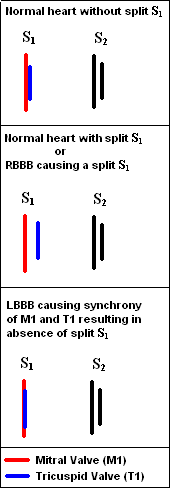General Cardiology Part 5
The first heart sound results from the closing of the mitral and tricuspid valves. The sound produced by the closure of the mitral valve is termed M1 and the sound produced by closure of the tricuspid valve is termed T1. The M1 sound is much louder than the T1 sound due to higher pressures in the left side of the heart, thus M1 radiates to all cardiac listening posts (loudest at the apex) and T1 is usually only heard at the left lower sternal border. The M1 sound is thus the main component of S1.
In about 40-70% of normal individuals, as well as in certain cardiac conditions, a "split S1" sound can be appreciated. This occurs when the mitral valve closes significantly before the tricuspid valve, allowing both valves to make an audible, separate sound. Inspiration delays the closure of the tricuspid valve in a normal person (due to increased venous return), thus enhancing the splitting of the S1 sound. Also, a split S1 sound is common in the setting of a right bundle branch block (RBBB) or ventricular tachycardia/PVCs with a RBBB morphology. A RBBB causes the electrical impulse to reach the left ventricle before the right ventricle. Dyssynchrony then occurs, resulting in the left ventricle contracting before the right ventricle, thus the pressures in the left ventricle rises before that of the right ventricle. This delays the closure of the tricuspid valve, resulting in a split S1 sound. A left bundle branch block (LBBB) has the opposite effect on S1. In this setting, the electrical impulse reaches the right ventricle before the left ventricle, thus the pressure in the right ventricle rises before that of the left ventricle. This forces the tricuspid valve closed earlier, resulting in complete overlap of M1 and T1 and thus no audible split S1 sound.

